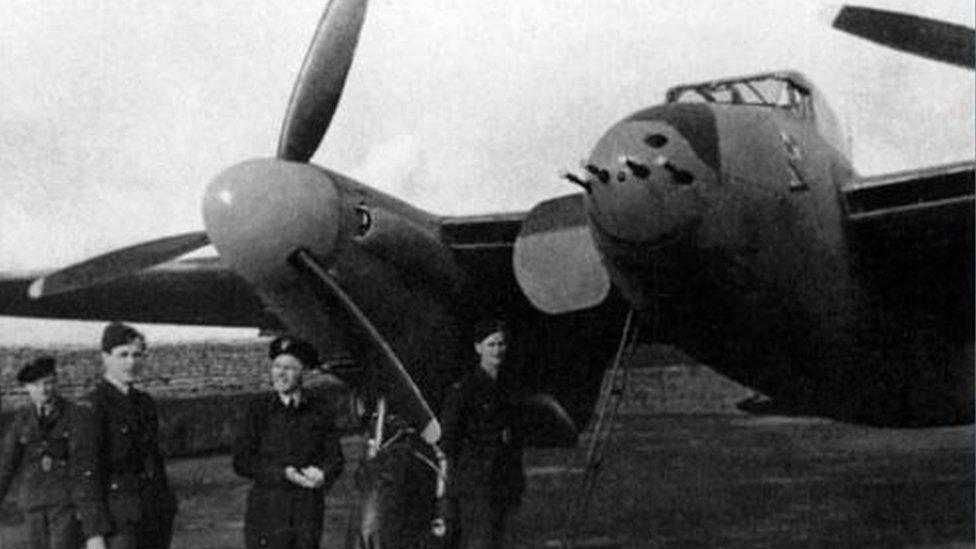The Eagle Owls Polish squadron who defended Exeter
- Published

Airmen from 307 Squadron were based at RAF Clyst Honiton from 1942 to 1943
A chance discovery in a graveyard has led to a wider understanding of the contribution made by Polish airmen in World War Two.
Historian Michael Parrott found a wooden plaque to 307 Squadron in an unused corner of a chapel in Exeter's Higher Cemetery in 2012.
That led to the unearthing of the role the night-fighter squadron, dubbed the Eagle Owls, played in defending the city from Nazi attacks.
Polish Air Force in World War Two
July 1940
The first Polish fighter pilots joined RAF Squadrons.
-
145 Polish airmen fought in the Battle of Britain
-
126 German planes destroyed by 303 Polish Fighter Squadron - the highest number of kills of any squadron in the Battle of Britain
-
29 Polish pilots lost their lives in Battle of Britain.
-
1,903 Polish Air Force personnel killed during World War Two
"I am a member of the Friends of Higher Cemetery and I was searching the history of the chapel there when I stumbled across this plaque," said Mr Parrott.
"I didn't know anything about 307 squadron at the time.
"I was aware there were Polish airmen buried there but I always wondered why and it has snowballed from there."

Capt Gerard Ranoszek of 307 Squadron with his Beaufighter at RAF Clyst Honiton
Between April 1941 and April 1943 the squadron was based at RAF Clyst Honiton, now Exeter Airport, defending the South West of England from enemy night bombers.
The squadron, which also had other members of other nationalities including Britons, Czechs and South Africans, flew Defiants, Beaufighters, and Mosquito planes.
In May 1942 when 40 Junkers-88 bombers attacked Exeter there were only four Polish 307 Squadron Beaufighters available to defend the city.
Despite being heavily outnumbered the squadron managed to shoot down four of the German bombers before they dropped their bombs.

The squadron shot down four German bombers before they dropped their bombs on Exeter
Mr Parrott said: "As a result the relationship between the city and the squadron grew considerably.
"On 15 November 1942 the 307 Squadron presented the city of Exeter with the Polish flag."
Squadron leader Jan Michałowski presented the flag to the then Mayor of Exeter, Rowland Glave-Saunders, saying: "May it remind (the people of Exeter) in the future when the war is over... that at one time Poles and Devonians lived, fought and died for one cause."

The squadron left RAF Clyst Honiton in April 1943 and moved to South Wales
The squadron left RAF Clyst Honiton in April 1943 and moved to south Wales before moving to other locations in the UK, including RAF Predannack in Cornwall.
It lost 21 airmen during the war and 19 of them are buried at Higher Cemetery in Exeter.

The squadron was also based at RAF Predannack in Cornwall during the war and was by then flying Mosquito planes
Over the years the flag in Exeter's Guildhall went missing and a new Polish flag was blessed in 2012, on the 70th anniversary of the original flag ceremony.
Every 15 November in Exeter is now 307 Squadron Day and the event is marked with an exhibition at the Guildhall organised by Mr Parrott and other members of 307 Squadron Project, external.
Tadeusz Wijaszko, who was in the squadron as a radar operator, was in the Polish Air Force and interned in Romania after the fall of Poland to the Germans.
He escaped internment and made his way to Marseilles and joined the French Air Force.

Tadeusz Wijaszko was a radar operator in 307 Squadron and settled in the area after the war
After the fall of France he was evacuated from Cherbourg to Britain where he joined the Polish squadron at the age of 25.
After the war, like many other Polish servicemen, he married and settled in the area after it became clear eastern Europe was under Soviet hegemony.
Resettlement camps were set up across the UK to house Poles and their families. Some remained open for decades. The very last one, Ilford Park, external in Devon, is still open and still run by the Ministry of Defence, as a home now for nearly 100 elderly Poles.
Mr Wijaszko died several years ago, but his son Tony Wijaszko, who still lives in Exeter, said he is "very proud" of his father, who was lucky to escape from Poland.
"The Germans overran an airfield where he was based and a soldier pulled a gun on him and it misfired."
The exhibition, For Your Freedom and Ours, is at Exeter Guildhall on Saturday and Sunday.
- Published15 September 2015

- Published28 June 2015

- Published1 September 2014

- Published4 August 2012